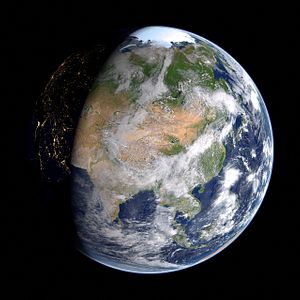There is a glaring disconnect between climate science and the economic and political narrative of a rising Asia, set to dominate the 21st century. Climate projections now point toward global warming far beyond the 1.5 degree Celsius danger line identified by science. If that happens, Asia’s economic hotspots will be badly affected. This could knock the region off its growth trajectory and put an untimely end to the Asian century.
Just a few years ago, no one could be faulted for predicting that the 21st century would be Asia’s. If anything, it seemed like a safe bet. And, yes, by all fundamental measures, economic and political power has shifted eastward. According to the World Economic Forum, Asia’s combined GDP is set to surpass the combined GDP of the rest of the world in purchasing power parity terms this year.
However, there is one thing that has not been factored in: climate change. If you read the literature about the Asian century, you will rarely come across this term. The world now is already 1°C hotter than in pre-industrial times. There is little doubt that the global average temperature will climb further. If far-reaching greenhouse gas reduction measures are taken now, it may be possible to hold the increase below 2°C. However, it is doubtful whether this will be achieved. If you sum up the current emission reduction pledges made under the Paris agreement, warming of 3°C or more by mid-century seems likely.
This will have a profound impact on the economic and political balance of the world as the 21st century progresses. The wealth of nations is not just built on comparative advantage. Above all, it rests on stable, predictable, and recurring climatic patterns within a narrow temperature band. This enables agricultural surplus, trade and long-term investment. Likewise, access to credit and insurance depends on predictable and manageable climate risks. Higher risk means higher cost of capital, declining growth rates, a drag on productivity, falling incomes, and, possibly, political instability.
Climate change is a formidable challenge for all world regions, but particularly for South, Southeast, and parts of East Asia where temperatures and humidity are already high and destructive weather events are already more prevalent and severe than elsewhere. Adding more heat to the region’s climate systems means moving into uncharted territory. A recent report from the International Panel on Climate Change (IPCC) shows that going from 1.5°C to 2°C of global warming makes a big difference. And, for the moment, 2°C warming or more is clearly the path the world is on. The impact will be asymmetrical. Asia’s most economically dynamic and densely populated places will be heavily affected. More frequent and extreme heat waves, droughts, and tropical cyclones will undermine the livelihoods and health of hundreds of millions and could sap the region of its economic dynamism.
The IPCC also warns that sea levels could rise by more than a meter by the end of the 21st century if carbon emissions do not go down. This would mean more frequent and severe inundation in Asia’s densely populated coastal areas, including megacities like Jakarta, Bangkok, and Shanghai, unless huge sums are spent on coastal protection measures. Some places have adaptation plans to prepare for these changes. Singapore alone expects to spend S$100 billion or more on protecting itself from the rising sea. The city-state already requires new building sites to be 4 meters above the current sea level, with stricter requirements for critical infrastructure. Less affluent and bigger Asian nations won’t be able to afford such measures and will suffer the consequences. The poorest households and communities will be worst affected.
Data from the International Energy Agency show that global energy-related greenhouse gas emissions would have fallen significantly last year, if emissions had not grown strongly in Asia. Despite an encouraging expansion of electricity from renewable sources in countries like China and India, coal consumption in Asia is still on the rise as energy demand keeps growing. This means that Asia is not just highly vulnerable to climate change, but also partly in control of how bad it gets.
Given current emission trends, there is simply no way for other parts of the world to compensate for the projected increase in Asia. Keeping the world below the 2°C mark requires a rapid shift toward renewable energy sources, such as solar and wind, and a strong push for energy efficiency. Continuing on a path of high-carbon growth and taking care of global warming and its effects later would be wrong and costly.
Global warming and its effects make the 21st century a century of unpredictability and, with it, the Asian century becomes uncertain. If we do not get a firm grip on greenhouse gas emissions soon, it will be no one’s century.
Andreas Unterstaller is a transport and environment expert at the European Environment Agency in Copenhagen. He holds a Master in Public Administration degree from Singapore’s Lee Kuan Yew School of Public Policy.

































